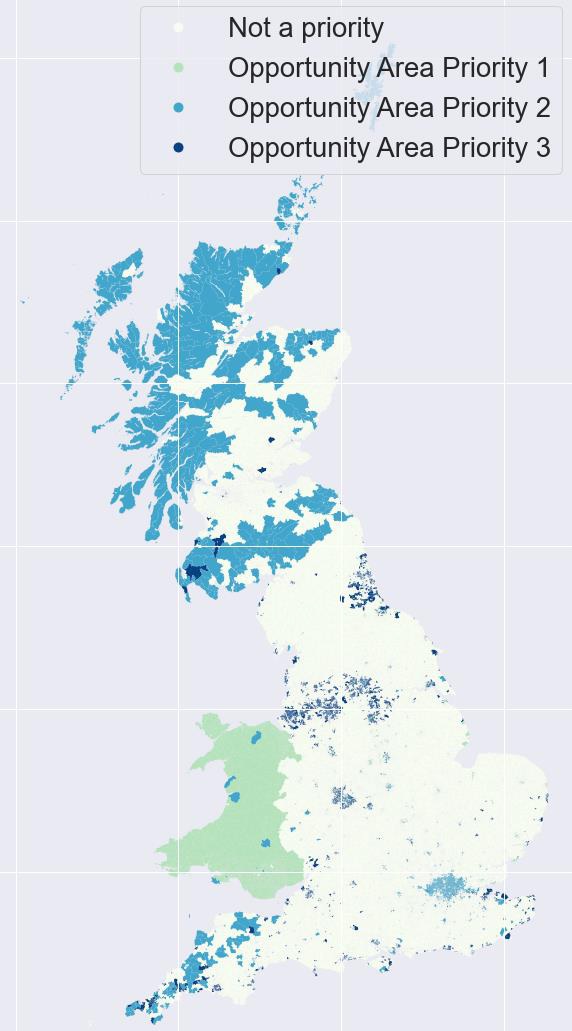Geodemographics - blogs and resources
Visit the Geodemographics Knowledge Base (GKB) for expert blogs and links to useful sources of geodemographic data and knowledge.
The MRS Census and GeoDems group champions new thinking and new talent; one area they have been particularly impressed with is the CDRC Masters Dissertation Scheme (MDS)
This programme offers an exciting opportunity to link students on Masters courses with leading retail companies on projects which are important to the retail industry. The scheme provides the opportunity to work directly with an industrial partner and to link students’ research to important retail and ‘open data’ sources. The project titles are devised by retailers and are open to students from a wide range of disciplines.
MRS CGG are proud to have been granted permission to publish abstracts from the dissertations and we are sure the students have a great future ahead of them.
This abstract is by Yasmine Hujair
Title: How and where to ‘Build Back Better’: evaluating socioeconomic and infrastructure investment disparity in Great Britain
Academic Institution: University College London
Industry Sponsor: Barbour ABI
Background and Motivation
Societal inequality transpired to be significantly influential in shaping health outcomes during the Covid-19 pandemic in 2020. Tackling inequality subsequently became instrumental in policy development and virtually synonymous with this effort is the ‘Build Back Better’ plan for growth. A Conservative Government invention, this concept harnesses the populist social movement towards socioeconomic parity and responds to the pandemic-induced recession with an optimistic and constructive initiative to create jobs, improve lives and reduce inequality. The policy targets infrastructure, innovation and skills as ‘pillars of growth’, and identifies infrastructure investment as an economic stimulus that will create opportunities for societal ‘levelling up’ as a tool for reducing disparity. The document specifically relates to England, Wales and Scotland, which is therefore the study area for this research.
The connection drawn between infrastructure investment and economic stimulus is not contentious. Infrastructure is often instrumental in economic growth, and it stands to reason that the built environment connects people, thus invigorating the economy through job creation, collaboration and innovation, not to mention the palpable sense of competition and talent attraction that comes with a well-functioning economy. However, much debate has been had regarding the optimisation of infrastructure investment, in particular the type, quality, quantity and location. The magnitude of stimulus one can expect is also subject to debate. The plan for growth optimistically details how the infrastructure investment will improve lives. This study considers the evidence base for such claims and whether the construction pipeline in its current state is going some way towards the identified goals.
Data and Methods
A range of publicly available socioeconomic indicators, including deprivation indicators and productivity measures, were used to comprehend the effect of public investment on the population and whether the construction pipeline is spatially optimised. Data representing investment has been provided by Barbour ABI and contains all past and planned projects in the UK between 1990 and 2030. The values associated with each project have been adjusted for inflation. The investment data has been recategorized using a bespoke methodology and distributed across wider geographies based on their value and categorisation.
A k-means clustering algorithm forms the basis of the study, which grouped geographies based on their similarity in relation to socioeconomic indicators and historical infrastructure investment. All variables were subject to data cleansing, standardisation and transformation iterations. The final iteration of data preparation utilised the Robust Scalar based on the 90th and 10th percentiles, and the Yeo-Johnson transformation. The k-means clustering algorithm grouped the data based on similarity to ultimately map areas that have varying levels of deprivation and other socioeconomic characteristics, as well as those that have or will benefit from historical or projected infrastructure investment. Four iterations were carried out of the k-means clustering process to optimise the results. The classifications were mapped per small area zone (a combination of Scottish datazones and English and Welsh lower super output areas) and used to identify opportunity areas for infrastructure investment and to evaluate the claims made in the Build Back Better policy framework.
Key Findings
The analysis in this study has provided an insight into the spatial distribution of the construction pipeline and demonstrated that historic and projected infrastructure investment does not significantly vary spatially and compared to one another, suggesting a greater deviation from these trends is required in the ‘Build Back Better’ campaign. Historical investment cannot be associated as the cause of socioeconomic spatial variation but does not disprove association either. This potentially undermines the conceptual foundation of ‘Building Back Better’. Not only is it unclear how to determine spatial prioritisation, but it is questionable whether, if this is resolved, disparity could be remedied through investment at all.
The clustering analysis has found areas that experience both a lack of funding and poor socioeconomic status, which has led to the identification of opportunity areas in the UK, shown in Figure 1. While infrastructure is crucial, the quality and type has not become clear from this macro analysis and should be considered by local policy makers in case-study analysis. Infrastructure alone is ostensibly not able to fundamentally change an economic system without further detail and local understanding. While some limitations may distort the results, the analysis is a constructive opening assessment for creating an evidence base for directed funding using socioeconomic data and form a framework for evaluating the policy in the future.
The current construction pipeline does not deviate from historical spatial investment trends. It appears that investment in infrastructure does not guarantee improvements in socioeconomic indicators, but there are areas of high deprivation in the UK that are receiving below average investment. If the ‘Build Back Better’ campaign sincerely wishes to reduce disparity, its success will depend on utilising a combination of the macroeconomic analysis in this methodology and a localised and well-considered strategy. A series of recommendations have been included in the report to refine the research to be used to evaluate the Build Back Better policy framework as it is developed further.
Figure 1


Visit the Geodemographics Knowledge Base (GKB) for expert blogs and links to useful sources of geodemographic data and knowledge.


Our newsletters cover the latest MRS events, policy updates and research news.
0 comments